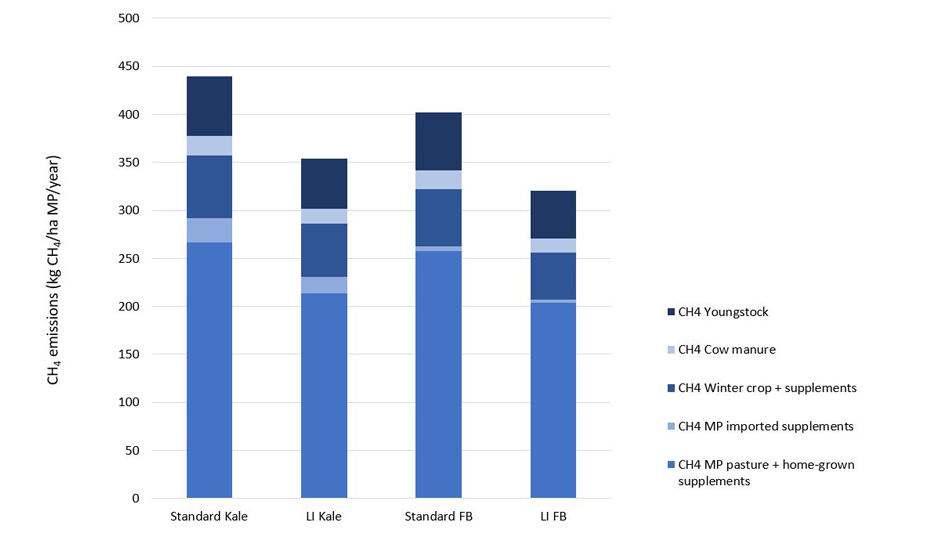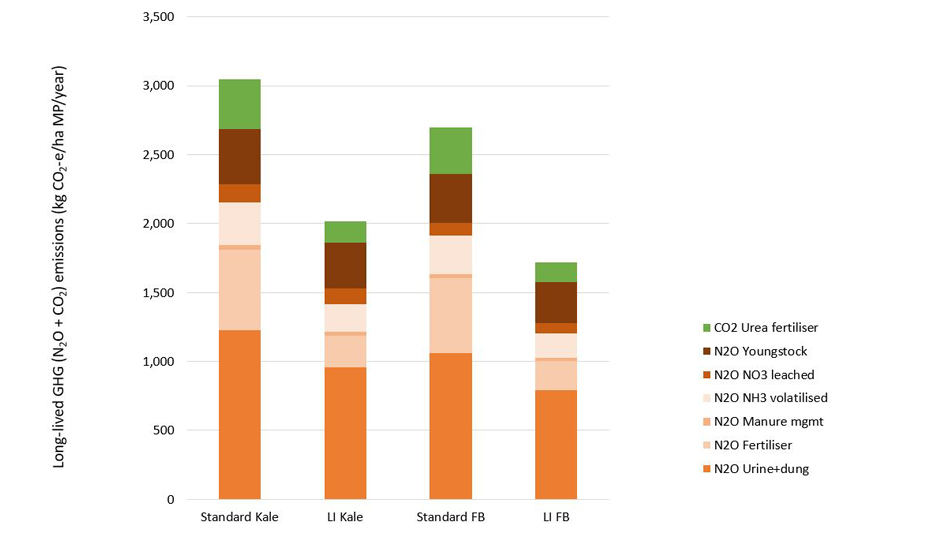Southern Dairy Hub
5 min read
The Southern Dairy Hub aims to address local dairy farming challenges through research and demonstrations. This page highlights the major studies conducted at the hub including a comparison of the feed regimes of cows on fodder beet and kale, and a four-year farm systems comparison, set up to study the effects of various winter feed crops and systems on milk production, profitability, and greenhouse gas emissions.
The Southern Dairy Hub was established in response to Southland and Otago farmers wanting dairy challenges in the region to be addressed through local research and demonstration.
For weekly data, field day notices, and newsletters visit the Southern Dairy Hub website.
Four farmlets comprising both standard and lower impact kale and fodder beet systems were set up in 2018 to address farmer concerns around wintering, fodder beet feeding, and meeting nutrient loss reduction targets.
Kale is used as a wintering crop alongside in-shed feeding as a supplement to lactation. Note: the numbers in the tables below are 2019-20 season values.
| Standard | Lower Impact | |
| Milking platform (ha) | 62.4 | 63.2 |
| N fert on pasture (kg N/ha) | 180 | 56 |
| N fert on crop (kg N/ha) | 151 | 145 |
| Total production (kgMS) | 77,688 | 65,854 |
| Profitability ($/ha) | $2,746 | $2,460 |
| Notes | No N applied after 10 April | N applications (Sep, Dec, Feb/Mar) up to 75kgN/ha |
Fodder beet is used as a wintering crop and as a lactation supplement during spring and autumn.
| Standard | Lower Impact | |
| Milking platform (ha) | 65.3 | 66.5 |
| N fert on pasture (kg N/ha) | 175 | 57 |
| N fert on crop (kg N/ha) | 149 | 155 |
| Total production (kgMS) | 77,104 | 62,400 |
| Profitability ($/ha) | $2,571 | $1,712 |
| Notes | No N applied after 10 April | N applications (Sep, Dec, Feb/Mar) up to 75kgN/ha |
The Greenhouse gas (GHG) footprint of the four comparison farmlets was calculated in the context of proposed He Waka Eke Noa emissions reporting for the 2019-20 season.
The footprints were broken down into contributions from different parts of the farm systems, and some potential costs were calculated based on indicative emissions price estimates.
At the SDH March 2022 Field Day, AgResearch Senior Scientist Tony van der Weerden discussed the GHG footprints of the four SDH farmlets in the context of proposed He Waka Eke Noa emissions reporting and potential pricings. Check out the highlights from his presentation below.
Participatory research project: Greenhouse gas footprints for the Southern Dairy Hub farmlets. Presented by AgResearch senior scientist Tony van der Weerden.
Video 5:26 min
The effect of a Lower Impact system (reduced N fertiliser and supplement use and thus lower stocking rate) had a much larger effect on GHG footprints than the choice of crop type, but came at a significant cost to profitability:

Methane (CH4) emissions from different parts of the farm systems.

Nitrous Oxide (N2O) and Carbon Dioxide (CO2) emissions emitted.
| GHG potential pricing for 2019-20 season (discounted cost) | ||||
| Standard kale | LI kale | Standard FB | LI FB | |
| Profitability ($/ha milking platform) | $2,746 | $2,460 | $2,571 | $1,712 |
| He Waka Eke Noa split-gas level | ||||
| $/ha milking platform | $61.30 | $47.46 | $55.66 | $42.55 |
| cents/kg MS | 4.9c | 4.6c | 4.7c | 4.5c |
Disclaimer: All prices used for this research are based on the He Waka Eke Noa pricing proposal that was released in June 2022. These are all indicative and estimates and the actual prices will not be confirmed until 2025 with the system to price agricultural emissions being decided on by the end of 2022.
Funding partners
The Participatory Research: Enhanced Research Adoption project, is part of DairyNZ’s research work with the Southern Dairy Hub. It started in July 2019 and ends in June 2022. It’s led by DairyNZ, run jointly with AgResearch, and funded by the Ministry for Primary Industries’ Sustainable Farming Fund. DairyNZ and the South Island Dairy Event are co-funders.
The winter crop feed study tested different winter feeding options and their carry over effects into lactation.
There is a growing concern about animal health and welfare issues when cows consume high quantities of fodder beet (FB), as the high-energy feed is deficient in some essential minerals (e.g. phosphorus) and low in protein. Regular updates tracking the progress of the treatments were published during the 17-18 season and a summary of results were presented in the November 17 and March 18 Field day notes.
Treatments were chosen to demonstrate differences between two feeding strategies; ad-lib feed allocation (high) and body condition score (BCS) targeted feed allocation (target).
These strategies were implemented with both kale and fodder beet.
High allocation cows were offered 3 kg DM/cow/day baleage and ad-lib crop to achieve 1.25 BCS gain.
The target allocation cows were offered 4.5 kg DM/cow/day baleage and crop to achieve a 0.7 BCS gain.
Accounting for differences in feed quality and utilisation, cows were expected to be consuming 160 MJME/cow/day (high) or 140 MJME/cow/day (target).
This resulted in four herds of 80 cows each; high kale, target kale, high FB and target FB. Transitioning to crop commenced on the 31/5/17.
Following the winter period, cows from each treatment will be evenly dispersed between the four herds that will be running during the season at SDH. All herds will be managed under the same control decision rules until autumn 2018.
| Feed allocation | |||
| High (kg DM/cow/day) | Target (kg DM/cow/day) | ||
| Crop type | Kale | 14 kg kale 3 kg baleage | 10.4 kg kale 4.5 kg baleage |
| Fodder beet | 11.9 kg FB 3 kg baleage | 9.1 kg FB 4.5 kg baleage | |
Now’s the perfect time to check in, plan, and set up for a strong season. We’ve pulled together smart tips and tools to help you stay ahead all winter long.
Whether you prefer to read, listen, or download handy guides, we’ve got you covered with trusted tools to support your journey every step of the way.